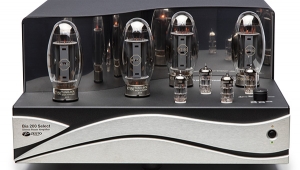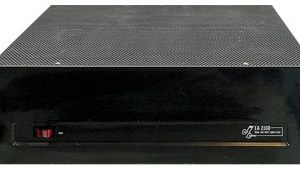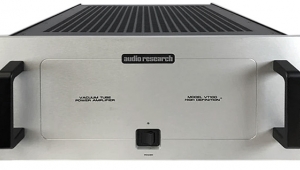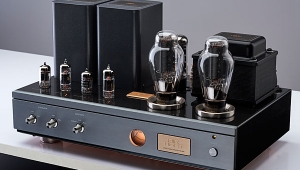| Columns Retired Columns & Blogs |
Audio Research Reference 110 power amplifier
When I attend Stereophile's annual Home Entertainment show, I rarely sit and listen to music for very long. Instead, I try to hit every room, press the flesh, find out about new products, and play a little jazz.
Footnote 1: I also returned many times to Continuum Audio Labs' room, to hear their Caliburn turntable and Cobra tonearm. Mikey is right—these products are extraordinary.

But HE2006, in Los Angeles, was different. I must have spent three hours listening critically to the wonderful music and sound I heard in the three rooms occupied by the Audio Research Corporation, who'd hooked up their Reference line of electronics to speakers from Thiel, Vandersteen, and Wilson. The ARC gear included the Reference CD7 CD player, the Reference 3 line-stage preamp, and the Reference 610T and Reference 210 power amplifiers. In each of these rooms, run by LA dealer Optimal Enchantment, the delicacy, detail, air, and sense of ease were such that I returned again and again to listen to a wide range of music (footnote 1).
After my fifth listening session in the room containing Vandersteen speakers, ARC's Dave Gordon cornered me. "As you're a VT100 Mk.II owner, you should be aware we will be shipping shortly a half-power stereo version of the Reference 220, the Reference 110, which replaces the VT100 Mk.III, which we discontinued a few months ago."
Naturally, I had to get a review sample of this new Reference component, to see how it would compare with the amp I've used as a main reference for over a decade now, in its Mk.I and Mk.II versions.
Design
I've been a fan of Audio Research products for many years, having owned several of their preamps and amplifiers. ARC doesn't hesitate to frequently update designs or experiment with new circuit topologies and tube types, to the point where some audiophiles have become frustrated with the company. Two things that don't change are the classic, conservative look of ARC products, and the company's commitment to customer service. ARC boasts that they will continue to service any product they've ever manufactured; their website currently promotes a new update for their SP-3 preamplifier, which they stopped making in 1976.
As they sat next to each other in my listening room, the family resemblance between the Reference 110 ($9995) and my VT100 Mk.II was strong. Aside from the 110's slightly deeper chassis and thicker faceplate, they were tough to tell apart. But a look inside at the circuit design showed the Ref 110 to be a completely different animal. This 110Wpc amplifier is based on a push-pull, fully balanced circuit using two matched pairs of 6550C output tubes per channel. The input stage, trickled down from ARC's flagship amp, the Reference 610T, uses direct-coupled JFETs with a driver stage based on 6H30 tubes, one for voltage gain and one used as a cathode-follower. Output tube biasing is accomplished using trim pots and insulated test points on the left and right circuit boards. The output-stage coupling is a combination of ultralinear and ARC's "partially cathode-coupled" topology, which the company claims yields better sound than conventional triode or pentode operation.
ARC pays more attention than most firms to circuit-board layout and wire routing. The Ref 110's right- and left-channel boards are mounted horizontally and flank the transformers, which are mounted on a raised central channel running from front to back. A small LCD display indicating the number of hours the tubes have been run is mounted on the front of one board and is visible though the top panel. Every tube amp should have such a display. The speed of the two small fans mounted on the rear panel is controlled with a three-way switch. The input is balanced XLR only, and there are pairs of ARC's rugged, proprietary speaker binding posts for the 4, 8, and 16 ohm taps. Two 12V triggers (input and output) allow remote turn-on. The Reference 110 is the first power amplifier I've had in house with a 20A IEC power cord.
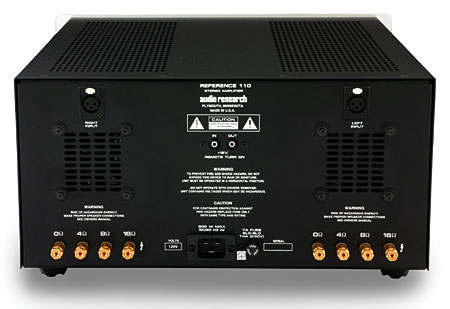
I installed the Reference 110 in my primary reference system, using my Audio Valve Eklipse and ARC's own Reference 3 line stages. However, as the Ref 110 provides only balanced inputs, I bought an MIT Magnum M3 interconnect to replace my single-ended MIT CVT-350 Twin Terminator, then spent quite a bit of time getting used to the sound of my new wire before doing any critical listening. In all four combinations of preamp and power amp I tried, I found the Magnum M3 more detailed, dynamic, and transparent than the older CVT-350, with more extended frequency extremes. Of course, I don't know how much of the improvement was due to the wire, and how much to running the electronics in balanced mode.
Listening
Over my many weeks of listening to the Reference 110, two things made it extremely special with all recordings.
First, the 110 could unravel layers of inner detail. This, combined with its extraordinary ability to convey hall ambience and low-level dynamic inflections on a wide, deep soundstage, rendered all good recordings with startlingly lifelike realism. With every one of my very familiar reference discs, I noticed many subtle nuances for the first time. Listening to Timothy Seelig and the Turtle Creek Chorale's recording of John Rutter's Requiem (CD, Reference RR-57CD), it was easy to tell where the choirs were standing within the recording space. The wall reflections of the church were easily discernible, and the blend of voices and pipe organ had an incredible sense of bloom. I'm used to the male choir on Brian Wilson's Smile (CD, Nonesuch 82946-2) sounding like a mass of identically replicated voices, but through the Reference 110 I could hear each singer's individual vocal signature so distinctly that I almost felt I could write out each vocal line on a sheet of music paper. The 110's dead-neutral midrange certainly helped. On Antal Dorati and the London Symphony's recording of Stravinsky's The Firebird (CD, Mercury Living Presence SR 90226), I noticed, buried way down in the mix toward the rear of the soundstage, delicate flute lines that were easy to follow no matter how complex or loud the surrounding orchestral passages.
Footnote 1: I also returned many times to Continuum Audio Labs' room, to hear their Caliburn turntable and Cobra tonearm. Mikey is right—these products are extraordinary.
- Log in or register to post comments
